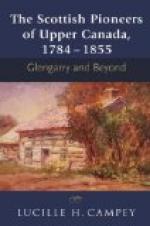Consequently, with all this in the air, it is not very surprising that the far-sighted John Jacob Astor, a wealthy German merchant of New York, should have conceived the idea of founding a great American fur-trading company and of establishing it at the mouth of the Columbia River.
At the beginning of the nineteenth century he had entered into arrangements with an Anglo-Canadian Company (the Mackinaw), which worked the southernmost part of Canada, to fuse its enterprise with his, and thus founded the South-west Company, the name of which (at any rate in current speech) was afterwards changed into the Pacific Fur-trading Company. After attempting in vain to come to a working arrangement with the great North-west Company, he decided to act quite independently and to establish the headquarters of his new concern at the mouth of the Columbia River. Accordingly, the expedition was sent out in duplicate to the mouth of the Columbia River, one-half going a six-months’ voyage round Cape Horn in a sailing ship, the Tonquin, and the other marching overland or canoeing on lakes and rivers in eighteen months from Montreal via the Mississippi and Missouri. These two parties together founded “Astoria”, at the mouth of the Columbia. But most of Astor’s employees were British subjects derived from men of the North-west and Mackinaw Companies; and when, in 1812, war broke out between the United States and Great Britain, a British war vessel came up the Pacific coast to Astoria and promptly turned it into “Fort George”. Forthwith the North-west Company bought up the derelict property of Mr. Astor’s Company from his not very honest British employees, and the few Americans in the concern retreated inland, and, after almost incredible sufferings from the attacks of unfriendly Indians, succeeded in reaching the Mississippi.




